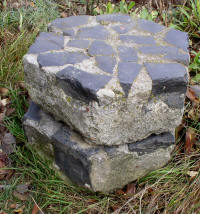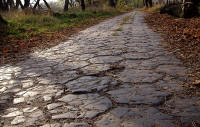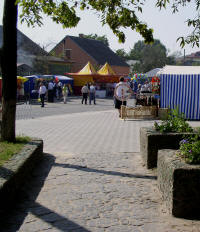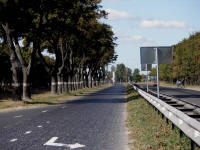Russian: трилинка
Polish: trylinka
That is a type of road pavement employing hexagonal pre-cast concrete blocks. They were nicknamed "trylinka" after its inventor, the Polish engineer Wladyslaw Trylinski who invented and patented this type of pavement in 1935. The production of blocks was started in Brest in the 1930s. The blocks were used to pave roads in Brest and other towns near Brest. The road Kobrin - Pinsk was paved with "trylinka". The pavement was strong enough to withstand numerous tanks and various heavy laden vehicles during the devastating war from 1941 till 1944. This type appeared to be the strongest of other types, invented in the 1930s. In the course of road reconstruction in the recent decade most of the trylinka pavement was replaced by asphalt. Fortunately, it remained, so far, in the Brest Fortress, in Pinsk, Stolin and some other places of Brest region.

I saw the two blocks of trylinka by a road in Brest after the pavement was replaced by asphalt. The harder upper layer features black basalt rocks.
The concrete of broken stones made the blocks extremely hard. A block was 15-20 cm thick, it had 6 sides, 20 cm each. Broken black basalt, brought from Ukrainian Janowa Dolina , was put into metal casts. Next a layer of high standard concrete mortar was poured into the cast and a layer of low standard concrete mortar completed the block. The heavy blocks were put with harder surface upwards to pave roads.
 "trylinka" in the Fortress of Brest. |
||
 in the old park of Stolin. |
 "trylinka" in Sovietskaya Street, Stolin. |
 "trylinka" on Stolin - Pinsk road, built in the 1930s, in the northern outskirts of Stolin. |

